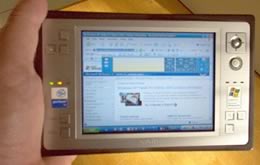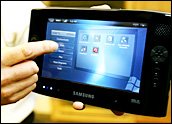
Looking for a great PC that runs a fully fledged version of Windows XP but weighs less than two pounds? Well, it's here _ at least if you can live without the "great" part.
The Samsung Q1 is one of the first computers made to Microsoft Corp.'s Ultra-Mobile PC specification, which was formerly known as the company's Project Origami.
It's a tablet-style computer, about the size of a trade paperback and at 1.7 pounds, only slightly heavier. It has a 7-inch screen with a few buttons around it, but no keyboard or mouse. If the Q1 were red, you'd think "Etch A Sketch" when you saw it.
The main way of communicating with the UMPC is by touching the screen, either with your fingers or an included stylus. It's the first time Microsoft has made a push for touch screens outside of its cell-phone and personal-digital-assistant software.
The concept is similar to the Windows XP Tablet PC Edition, which launched in 2002, but Microsoft has encouraged tablet manufacturers to use screens that don't respond to touch, only to special battery-powered styluses.
Also, Tablet PCs are usually the size and shape of laptops, with built-in keyboards. The UMPC is a more stripped-down device, limited in its uses and easier to carry around.
The Q1 lists for $1,100. Some have complained about that price, but I think it's mostly a matter of disappointed expectations _ Microsoft had said the UMPCs would cost between $500 and $1,000. The other manufacturer in the first wave of UMPCs, TabletKiosk, is shipping a "limited" production run of its own device for $900, and is expecting more inventory in a month or so. Asus is also bringing out a UMPC.
The Q1 is still cheaper than Tablet PCs, which start at $1,500. Laptops that weigh 2 to 3 pounds usually cost $2,000. The OQO, an even smaller computer that weighs less than a pound, costs $2,100 in its tablet version, and its 5-inch screen is pretty squint-worthy.
The Q1 has a 900-megahertz Intel Celeron processor and a 40 gigabyte hard drive, all sufficient for its likely uses. It doesn't have an optical drive, so you may not be able to install all the software you need unless you get Samsung's optional drive.
So who needs a UMPC? Well, Samsung sees students and salespeople as the early adopters. I think they're wrong.
Students need something they can write and play games on, and the UMPC isn't it. You can write on it with the stylus, and the software does a great job of recognizing what you write, but it gets tiresome.
You can also call up an on-screen keyboard for thumb-typing while holding the device, but it really doesn't work well. It obscures too much of the screen and it doesn't work when you hold the screen vertically because the "keys" overlap. Thirdly, the power cable connects exactly where you need to hold your right hand for thumb-typing.
Looking for a great PC that runs a fully fledged version of Windows XP but weighs less than two pounds? Well, it's here _ at least if you can live without the "great" part.
The Samsung Q1 is one of the first computers made to Microsoft Corp.'s Ultra-Mobile PC specification, which was formerly known as the company's Project Origami.
It's a tablet-style computer, about the size of a trade paperback and at 1.7 pounds, only slightly heavier. It has a 7-inch screen with a few buttons around it, but no keyboard or mouse. If the Q1 were red, you'd think "Etch A Sketch" when you saw it.
The main way of communicating with the UMPC is by touching the screen, either with your fingers or an included stylus. It's the first time Microsoft has made a push for touch screens outside of its cell-phone and personal-digital-assistant software.
The concept is similar to the Windows XP Tablet PC Edition, which launched in 2002, but Microsoft has encouraged tablet manufacturers to use screens that don't respond to touch, only to special battery-powered styluses.
Also, Tablet PCs are usually the size and shape of laptops, with built-in keyboards. The UMPC is a more stripped-down device, limited in its uses and easier to carry around.
The Q1 lists for $1,100. Some have complained about that price, but I think it's mostly a matter of disappointed expectations _ Microsoft had said the UMPCs would cost between $500 and $1,000. The other manufacturer in the first wave of UMPCs, TabletKiosk, is shipping a "limited" production run of its own device for $900, and is expecting more inventory in a month or so. Asus is also bringing out a UMPC.
The Q1 is still cheaper than Tablet PCs, which start at $1,500. Laptops that weigh 2 to 3 pounds usually cost $2,000. The OQO, an even smaller computer that weighs less than a pound, costs $2,100 in its tablet version, and its 5-inch screen is pretty squint-worthy.
The Q1 has a 900-megahertz Intel Celeron processor and a 40 gigabyte hard drive, all sufficient for its likely uses. It doesn't have an optical drive, so you may not be able to install all the software you need unless you get Samsung's optional drive.
So who needs a UMPC? Well, Samsung sees students and salespeople as the early adopters. I think they're wrong.
Students need something they can write and play games on, and the UMPC isn't it. You can write on it with the stylus, and the software does a great job of recognizing what you write, but it gets tiresome.
You can also call up an on-screen keyboard for thumb-typing while holding the device, but it really doesn't work well. It obscures too much of the screen and it doesn't work when you hold the screen vertically because the "keys" overlap. Thirdly, the power cable connects exactly where you need to hold your right hand for thumb-typing.
From the Washington post http://www.washingtonpost.com/wp-dyn/content/article/2006/05/03/AR2006050302059.html








